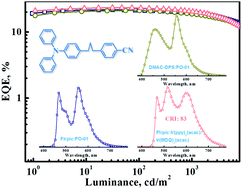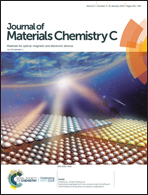A universal host material with a simple structure for monochrome and white phosphorescent/TADF OLEDs†
Abstract
The development of universal host materials suitable for both phosphorescent and thermally activated delayed fluorescent (TADF) emitters is still a bottleneck for fabricating highly efficient full-color and white organic light-emitting diodes (OLEDs) with a simple device structure. In this paper, two novel donor–acceptor type bipolar hybrids with simple molecular structures, 4′-(diphenylamino)-[1,1′-biphenyl]-4-carbonitrile (TPA-BN) and 4-(3-(4-(diphenylamino)phenyl)propyl)benzonitrile (TPA-L-BN), were designed and synthesized by combining triphenylamine as the electron-donating unit with benzonitrile as the electron-accepting unit. Their thermal, morphological, electrochemical, photophysical, charge transporting, and electroluminescent properties were comprehensively characterized for demonstrating their potential use as host materials for the fabrication of both phosphorescent and TADF OLEDs. The introduction of a flexible aliphatic spacer into TPA-L-BN gives rise to a high triplet energy of 2.95 eV due to the interruption of π-conjugation. The phosphorescent and TADF OLEDs based on the two hosts exhibit superior electroluminescence (EL) performance with high efficiencies and low roll-offs, employing a simplified and unified device structure. In particular, TPA-L-BN can host deep blue to red phosphorescent emitters and the blue TADF emitter with external quantum efficiencies over 20%. In addition, highly efficient all phosphorescent and TADF/phosphorescent hybrid white OLEDs (WOLEDs) with complementary emitters were realized using TPA-L-BN as the single host material. TPA-L-BN was also adopted to fabricate single-host three primary color WOLEDs, producing maximum efficiencies of 57.1 cd A−1, 53.6 lm W−1, and 23.4% with a high color rendering index of 83. The EL spectra of all these WOLEDs showed remarkable color stability with very small color variations across the whole range of luminance. More importantly, the TPA-L-BN hosted device presented a longer lifetime than that of the device based on TPA-BN, because of the improved morphological stability of TPA-L-BN in the emitting layer. These excellent results obtained using the non-conjugated bipolar hybrid host TPA-L-BN show that the introduction of the flexible linkage between the donor and the acceptor is an effective approach to construct universal host materials for highly efficient and stable phosphorescent and TADF OLEDs.



 Please wait while we load your content...
Please wait while we load your content...